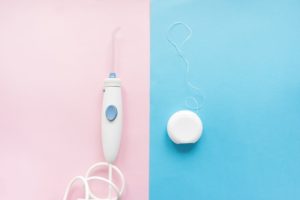 When it comes to oral care, the first thing that comes to mind for most people is brushing their teeth—and rightly so! Brushing daily is crucial for maintaining a happy and healthy smile, but it’s not all that’s important. Flossing, though sadly often neglected, matters too! Flossing allows you to clean the spaces inside of your mouth that your toothbrush can’t reach. But many people aren’t quite sure how to approach flossing, nor do they know what to actually floss their teeth with. Keep reading to learn more from your dentist about traditional dental floss and Waterpiks, two primary means of flossing, and which you should consider for taking care of your smile.
When it comes to oral care, the first thing that comes to mind for most people is brushing their teeth—and rightly so! Brushing daily is crucial for maintaining a happy and healthy smile, but it’s not all that’s important. Flossing, though sadly often neglected, matters too! Flossing allows you to clean the spaces inside of your mouth that your toothbrush can’t reach. But many people aren’t quite sure how to approach flossing, nor do they know what to actually floss their teeth with. Keep reading to learn more from your dentist about traditional dental floss and Waterpiks, two primary means of flossing, and which you should consider for taking care of your smile.
Reliable, Traditional Dental Floss
Dental floss has played a large role in the way we’ve cleaned our teeth for centuries. Modern dental floss is typically made out of nylon and comes in either waxed or unwaxed strands, as well as a variety of different lengths, thicknesses, colors, and flavors. You’ve probably also seen the dental floss picks you can purchase, which are handy little plastic tools with precut strands of floss attached. These tools are often much easier to handle than traditional floss, and just as effective.
Dental floss, when wielded correctly, can easily and effectively clean every tooth inside of your mouth. It removes lingering food particles and bacteria that becomes stuck between your teeth before plaque and tartar can develop. Although, people with teeth that are particularly close together might have issues when flossing with traditional floss. There’s also the possibility of flossing too hard, which can hurt your gumline and cause bleeding. However, dental floss is still completely safe to use and is strongly recommended alongside brushing, as it greatly mitigates issues like cavities, tooth loss, and gum disease.
The Innovative Waterpik
Funnily enough, the first Waterpik was invented by a dentist and one of his patients, who happened to be a hydraulic engineer. Also called oral irrigators, Waterpiks utilize a pressurized stream of pulsating water to clean away food particles, bacteria, and plaque between teeth and under the gumline. They make flossing much easier for patients who have braces, crowns, implants, or other types of nonremovable solutions. But not only do they make flossing easier; they can also reach spaces inside the mouth that traditional floss can’t even reach. Just be mindful that Waterpiks cannot completely remove plaque from the surface of your teeth—they are by no means a substitute for brushing!
Which Is Better for Cleaning My Teeth?
The bottom line is that both of these methods are effective—as long as you stick with one! When it comes to flossing and maintaining a healthy smile, consistency is key. Research indicates that there’s very little difference in how effective both methods are. That said, many people still prefer to use traditional dental floss or floss sticks over Waterpiks, as it gives them full control of the cleaning process. But others claim that nothing cleans their teeth quite like their Waterpik! So ultimately, the choice is up to you—there’s no wrong answer as long as you’re flossing.
If you have any questions or concerns about flossing, don’t hesitate to ask your dentist about how you should go about the habit. Flossing might not always be easy, but it’s certainly always worth it!
About the Author
An Orange County native herself, Dr. Renu Michelsen has proudly served patients and families in the area for several years. Dr. Michelsen received her dental doctorate from the University of the Pacific Art A. Dugoni School of Dentistry and is a member of several professional organizations including the American Dental Association and the California Dental Association. Her practice is pleased to offer many available services including preventive, cosmetic, and restorative care options. If you have any questions about the article or would like to schedule an appointment, feel free to contact Dr. Michelsen through her practice’s website or by phone: (714) 492-1169.
 Request
Request